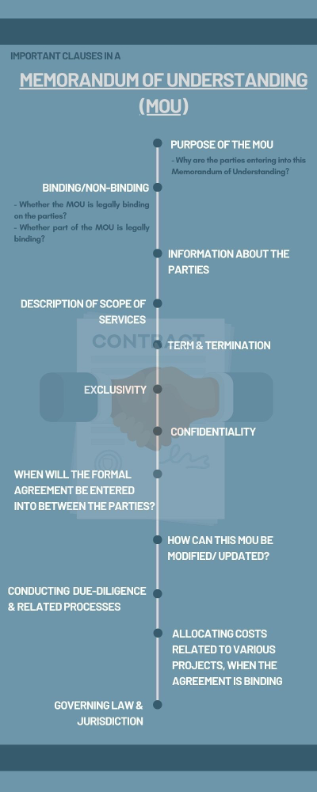Hi Folks!
Happy Good Friday!
Hope you’re doing great.
Let’s discuss about my favourite document - MoU.
Favourite because I always have a MoU in place for my clients before signing any other complex document. Helps me navigate through stuff easily.
Great. So let’s talk about what a MoU is:
A Memorandum of Understanding (MOU) is an understanding between two parties that sets forth the parameters of a potential agreement. It is typically used as a first step before the parties reach a formal agreement.
The reason for creating an MOU is to lay out the intention of the parties and create an understanding about the subject matter. MOU is legally non-enforceable but it is upon the drafting of MOU clauses that could later determine binding nature.
To better understand let’s take a simple sale agreement between A & B and understand what the essential clauses in MOU entail.
Purpose of the MOU:
This clause sets out the reason for which the parties are creating the MOU. The purpose is to determine the intention of parties entering into a contract and these determinants act as the background if any future disputes arise.
Scenario: - Consider A as a seller and B as a buyer. A and B are entering into an understanding of dealing in plastic bowls. A will be selling five pink plastic bowls to B for a consideration of Rs. 500.
Binding/Non-Binding:
The parties decide which terms should be legally binding and which ones should not. It is legally enforceable in one situation but not the other due to its binding and non-binding character.
Information about the Parties:
Under this clause each party to the Agreement is mentioned and described. It contains the name of the parties, organisation they belong to the duty they are disposing of etc.
Scenario: - For the purpose of this MOU, Party A who owns the sole proprietorship firm XYZ Stores is the seller. Party B who owns sole proprietorship firm VBN Stores is the buyer.
Party A is the seller of plastic bowls and Party B is the buyer of plastic bowls mentioned.
Description of Scope of Services:
This is a crucial clause of the MOU as under this clause all the responsibilities and duties are clearly identified. If the parties have a shared responsibility that is also to be clearly identified and mentioned.
Scenario: - The parties to this Agreement understands the following duties and responsibilities and will dispose these as to best of their abilities or standard mentioned in this Agreement: -
A______
B_______
Term & Termination:
This clause determines the period from which the MOU will commence and the dissolution period of the Agreement. The circumstances of termination of the MOU are also mentioned.
Scenario: - The term of this MOU is till the time the parties enter into a formal Agreement. Each Party shall have the right to terminate the Memorandum of Understanding by giving three - months' written notice in writing to the other Party at any time.
Exclusivity:
Exclusivity clauses, also known as non-compete clauses, forbid one party from propositioning deals or making deals with a third party for a set period of time.
Scenario: - From the date of this Agreement, neither party will directly or indirectly enter into negotiations, solicitations or contracts on the same terms as of this Agreement.
Confidentiality:
This clause mandates the parties to a level of privacy provisions related to the transaction. This is particularly important when parties enter into a transaction of intellectual property or trade secrets which is to be protected from third parties.
Scenario: - The parties agree that without prior consent from the opposite party, neither party shall disclose any provisions of this MOU, or its existence, to any other party.
When will the formal Agreement be entered into between parties:
As per this clause, a tie period is set out under which the formal Agreement is entered into between parties.
Scenario: - Upon executing this MOU by the parties, Party A will prepare the formal Agreement laying out all the business terms and conditions in detail, and subject to the approval of both the parties; the parties will enter into the formal Agreement.
How can this MOU be modified/updated:
As per this clause, the terms under which the MOU can be altered and amended are agreed upon by the parties mutually.
Conducting Due-Diligence & Related Processes:
As per this clause, the parties reasonably cooperate with each other to facilitate reasonable due diligence into the matters that relate to the subject matter of the Agreement and in connection to the transaction.
Scenario: - The parties agree that the buyer will have until the expiration of 10 (tenth) business day after delivery of the goods supplied by the seller to conduct all its exception and due diligence and as this period expires so does the buyer’s right to indemnification.
Allocating Costs related to various projects, when the Agreement is binding:
This clause mentions what type of cost will be borne by which party. This clause is particularly essential to set out the obligations and to reduce the chances of legal implications.
Scenario: - Both the parties mutually agree that the delivery cost would be borne by Party B i.e., the buyer in entirety and the party would be responsible to reimburse Party A i.e., seller.
Governing Law & Jurisdiction:
This clause sets out the jurisdiction under which a legal suit would be tried and under which law the Agreement would be governed.
Scenario: - This Agreement and any disputes or claims shall be governed by laws of ________, the Court of _____ shall have jurisdiction over all the matters arising out of this Agreement.
Here’s a simple depiction of terms in a MoU through an infographic.
Let’s connect if you have any further questions.
See you in the next one.
Best,
Lipi



